
Blackface is the practice of non-black performers using burnt cork or theatrical makeup to portray a caricature of black people on stage or in entertainment.
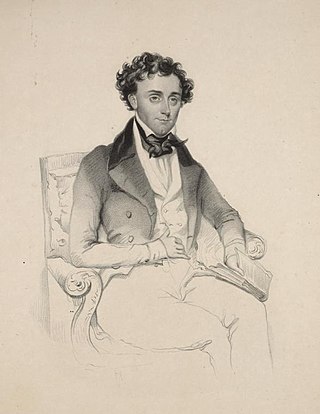
Thomas Dartmouth Rice was an American performer and playwright who performed in blackface and used African American vernacular speech, song and dance to become one of the most popular minstrel show entertainers of his time. He is considered the "father of American minstrelsy". His act drew on aspects of African American culture and popularized them with a national, and later international, audience.
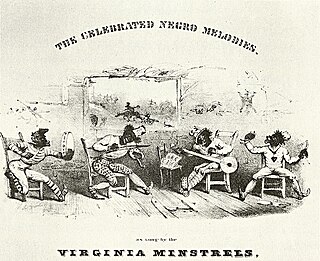
The minstrel show, also called minstrelsy, was an American form of theater developed in the early 19th century. The shows were performed by mostly white actors wearing blackface makeup for the purpose of comically portraying racial stereotypes of African Americans. There were also some African-American performers and black-only minstrel groups that formed and toured. Minstrel shows stereotyped blacks as dimwitted, lazy, buffoonish, cowardly, superstitious, and happy-go-lucky. Each show consisted of comic skits, variety acts, dancing, and music performances that depicted people specifically of African descent.
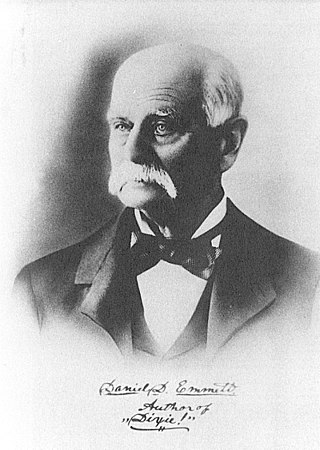
Daniel Decatur Emmett was an American composer, entertainer, and founder of the first troupe of the blackface minstrel tradition, the Virginia Minstrels. He is most remembered as the composer of the song "Dixie".
"Carry Me Back to Old Virginny" is a song written circa 1878 by James A. Bland (1854–1911), an African-American composer and minstrel performer. It was Virginia's state song from 1940 until 1997.

The latter part of the 19th century saw the increased popularization of African American music and the growth and maturity of folk styles like the blues.
"Jimmy Crack Corn" or "Blue-Tail Fly" is an American song which first became popular during the rise of blackface minstrelsy in the 1840s through performances by the Virginia Minstrels. It regained currency as a folk song in the 1940s at the beginning of the American folk music revival and has since become a popular children's song. Over the years, several variants have appeared.

"Old Dan Tucker," also known as "Ole Dan Tucker," "Dan Tucker," and other variants, is an American popular song. Its origins remain obscure; the tune may have come from oral tradition, and the words may have been written by songwriter and performer Dan Emmett. The blackface troupe the Virginia Minstrels popularized "Old Dan Tucker" in 1843, and it quickly became a minstrel hit, behind only "Miss Lucy Long" and "Mary Blane" in popularity during the antebellum period. "Old Dan Tucker" entered the folk vernacular around the same time. Today it is a bluegrass and country music standard. It is no. 390 in the Roud Folk Song Index.
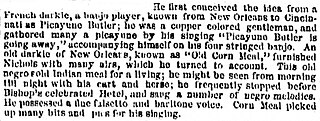
John "Picayune" Butler was a black French singer and banjo player who lived in New Orleans, Louisiana. He came to New Orleans from the French West Indies in the 1820s. One of his influences was Old Corn Meal, a street vendor who had gained fame as a singer and dancer at the St. Charles Theatre in 1837. By the 1820s, Butler had begun touring the Mississippi Valley performing music and clown acts. His fame grew so that by the 1850s he was known as far north as Cincinnati. In 1857, Butler participated in the first banjo tournament in the United States held at New York City's Chinese Hall, but due to inebriation, he only placed second.

The Padlock is a two-act 'afterpiece' opera by Charles Dibdin. The text was by Isaac Bickerstaffe. It debuted in 1768 at the Drury Lane Theatre in London as a companion piece to The Earl of Warwick. It partnered other plays before a run of six performances in tandem with The Fatal Discovery by John Home. "The Padlock" was a success, largely due to Dibdin's portrayal of Mungo, a blackface caricature of a black servant from the West Indies. The company took the production to the United States the next year, where a portrayal by Lewis Hallam, Jr. as Mungo met with even greater accolades. The libretto was first published in London around 1768 and in Dublin in 1775. The play remained in regular circulation in the U.S. as late as 1843. It was revived by the Old Vic Company in London and on tour in the UK in 1979 in a new orchestration by Don Fraser and played in a double-bill with Garrick's Miss In Her Teens. The role of Mungo was, again, played by a white actor. Opera Theatre of Chicago have recently revived the piece (2007?) where, it would seem, the role of Mungo was changed to that of an Irish servant.
"Clare de Kitchen" is an American song from the blackface minstrel tradition. It dates to 1832, when blackface performers such as George Nichols, Thomas D. Rice, and George Washington Dixon began to sing it. These performers and American writers such as T. Allston Brown traced the song's origins to black riverboatsmen. "Clare de Kitchen" became very popular, and performers sometimes sang the lyrics of "Blue Tail Fly" to its tune.
"De Wild Goose-Nation" is an American song composed by blackface minstrel performer Dan Emmett.
"Walk Along John", also known as "Oh, Come Along John", is an American song written for the blackface minstrel show stage in 1843. The lyrics of the song are typical of those of the early minstrel show. They are largely nonsense about a black man who boasts about his exploits.
"Miss Lucy Long", also known as "Lucy Long" as well as by other variants, is an American song that was popularized in the blackface minstrel show.

"Old Black Joe" is a parlor song by Stephen Foster (1826–1864). It was published by Firth, Pond & Co. of New York in 1860. Ken Emerson, author of the book Doo-Dah! (1998), indicates that Foster's fictional Joe was inspired by a servant in the home of Foster's father-in-law, Dr. McDowell of Pittsburgh. The song is not written in dialect.

Tom show is a general term for any play or musical based on the 1852 novel Uncle Tom's Cabin by Harriet Beecher Stowe. The novel attempts to depict the harsh reality of slavery. Due to the weak copyright laws at the time, a number of unauthorized plays based on the novel were staged for decades, many of them mocking the novel's social message, and leading to the pejorative term "Uncle Tom".
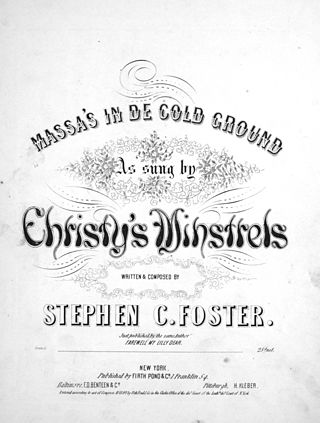
Massa's in De Cold Ground (1852) is a song by Stephen Foster.

The Jim Crow persona is a theater character developed by entertainer Thomas D. Rice (1808–1860) and popularized through his minstrel shows. The character is a stereotypical depiction of African-Americans and of their culture. Rice based the character on a folk trickster named Jim Crow that had long been popular among enslaved black people. Rice also adapted and popularized a traditional slave song called "Jump Jim Crow" (1828).

Hambone's Meditations was a comic strip produced from 1916 to 1968, and syndicated initially by the McClure Newspaper Syndicate and later by the Bell Syndicate. Produced by two generations of the Alley family, the one-panel cartoon originated with the Memphis, Tennessee, newspaper The Commercial Appeal, where it ran on the front page. The title character was a stereotypical African-American man with wide eyes and exaggerated large lips. He dispensed folk wisdom in caricatured dialect.













